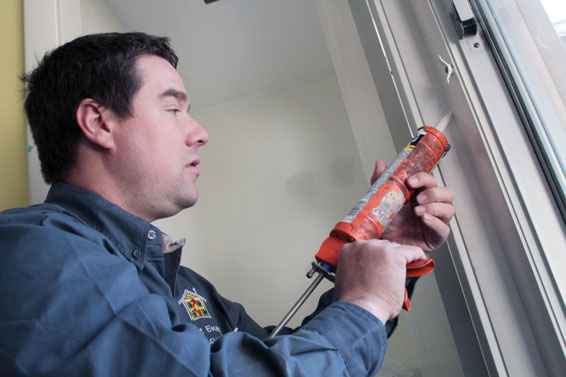Blog
Weatherization Tips from the Ground Up: Living Spaces

With the official arrival of fall, there is no better time to get started on weatherization projects that can help improve your comfort and cut heating costs as the temperature begins to dip. All it takes is a little effort and know-how to reduce the cost of the upcoming heating season.
This blog is the second of a short series focused on home weatherization tips for the heating season. Last time, we explored basement weatherization. This time, we’re focusing on living spaces throughout your home.
While insulation was the star of the show in our last blog, the hero of today’s post is air sealing.
If you’ve ever felt a draft of cold air in an otherwise warm room, heated air is escaping somewhere else. And that means you’ve found an air sealing opportunity! Any time heated air is displaced by cold outdoor air, your heating system has to work harder to maintain your desired indoor air temperature. This is how poor weatherization can drive up your energy costs. Outdoor winter air leaking into the home also tends to be extremely dry, which can also have a negative affect on indoor comfort. Sealing those leaks properly is an easy way to reduce heating costs and improve comfort.
While professional energy auditors can help you identify and prioritize major air-sealing projects – you can find one through Efficiency Maine’s Residential Registered Vendor locator – there are also simple, do-it-yourself measures you can take right away.
These are the most common materials you’ll find in a do-it-yourself air-sealing toolkit and where to use them:
Weather stripping
Great for sealing around windows and doors that don’t close tightly, weather stripping comes in many varieties. Rolls of circular and rectangular foam, as well as molded rubber weather stripping are the most common and can be found with or without adhesive strips.
Door sweeps
These small brushes or flexible rubber gaskets are installed on the bottom of many exterior doors to help seal the gap between the bottom of the door and the threshold. They provide a physical barrier that keeps out cold drafts in winter (and hot air in summer).
Caulk
Flexible and ideal for sealing small cracks and gaps in stationary building components, caulk is a great solution for drafty door frames and the surrounding trim. When some woods contract in dry winter air, they can create small gaps that can allow cold air to come in and warm air to seep out.
Spray foam
When it seems like caulk isn’t going to do the trick, spray foams can expand to fill larger gaps and penetrations (see below).
Rope caulk or caulk cord
Usually coils or strips of putty, these options offer a flexible, often removable option for sealing closed windows or doors for the heating season. It’s especially useful for temporarily sealing rarely used windows and doors, such as a basement door that is unused in the winter. Many types of rope caulk can be easily removed in the spring, stored in a plastic bag, and reused.
Now that you know the materials for the job, let’s focus on a few other weatherization considerations.
Windows
Leverage your windows and window treatments for the heating season. You can open curtains or blinds on south-facing windows to let in warmth from the sun. However, this technique is less effective if you have “low-e” windows that reflect heat and help stabilize your indoor temperature. In the evenings, closing curtains or drapes can also help you retain indoor heat through the night.
Also consider installing storm windows, transparent plastic film, or indoor window inserts to reduce heat loss in older, loosely hung or single-glazed windows. These options can create helpful barriers when installed correctly, helping maximize the benefits of other air-sealing measures.
Penetrations
As we mentioned in our last weatherization blog post, areas where plumbing or electrical lines pass through walls or floors can create troublesome gaps that result in undesirable heat loss. Spray foam, weatherstripping, and other kinds of gaskets, which vary depending on the size and type of gap you’re trying to close, can help you minimize this issue.
Receptacles and switch boxes are a terrific place to make an impact too. You can seal outlets and switch boxes with foam gaskets to reduce drafts and create a barrier between warmer and cooler air.
Proper weatherization and air-sealing practices can increase your home’s heating efficiency and provide better comfort and energy savings throughout the heating season. There are many affordable air sealing options that you can do yourself. However, working with an Efficiency Maine Residential Registered Vendor may make more sense when you’re considering larger weatherization projects and want to ensure that your project qualifies for Efficiency Maine insulation and air sealing rebates.
For more energy efficiency tips, review the Efficiency Maine Energy Efficiency Tips Booklet on our website here. To order a free printed copy of the booklet, email info@efficiencymaine.com, call 866-376-2463, or select it from our online order form here.
